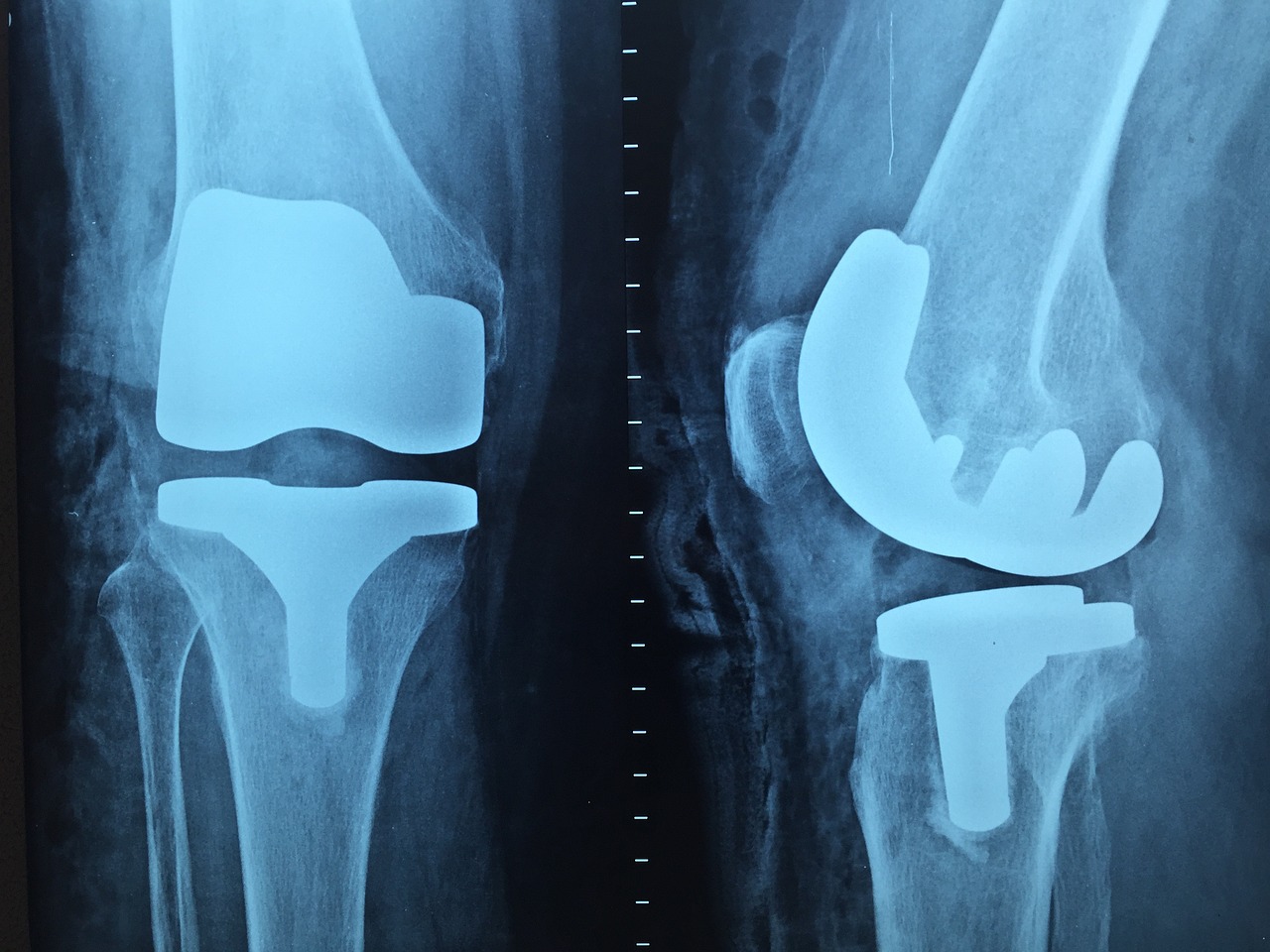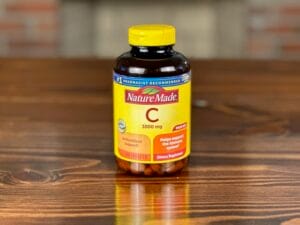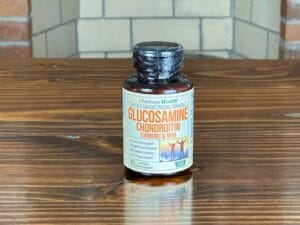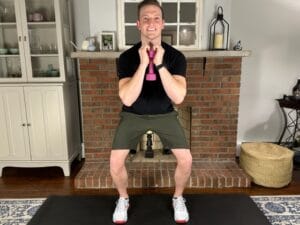Updated on December 17, 2025
Quick Guide: 7 Best Exercises After a Knee Replacement (Phase one: 0-3 weeks)
1. Hamstring stretch
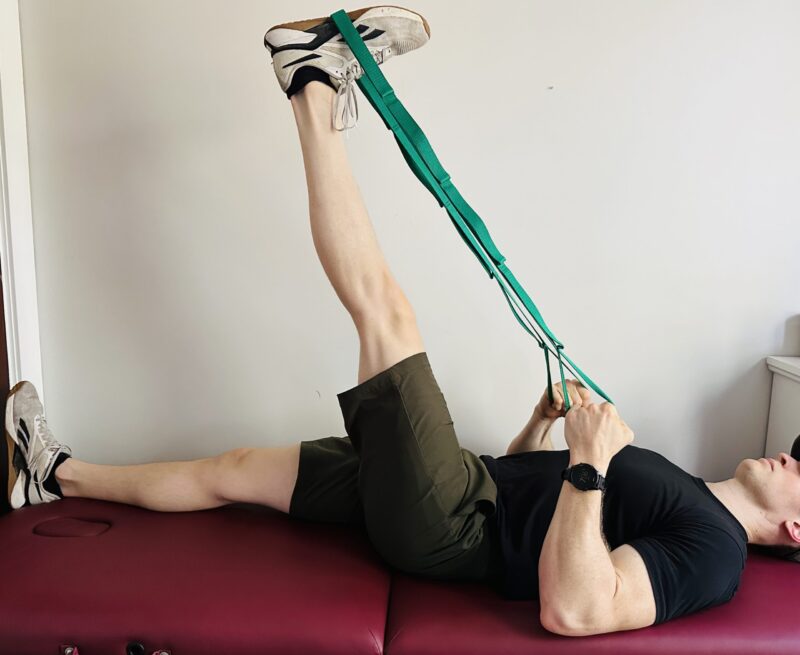
- Stretches the big muscle on the back of your thigh
- Important for increasing knee extension
- Hold this stretch for 20 seconds and repeat 5 times
- Best Stretching Strap in the link below
2. Calf stretch
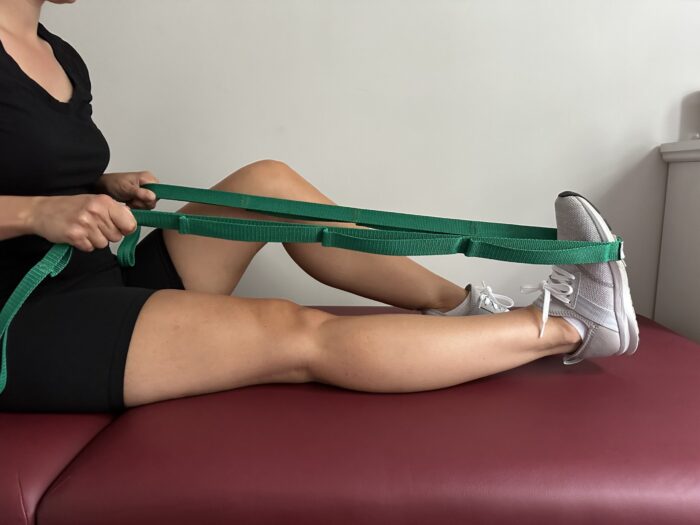
- Stretches the muscle on the back of your lower leg
- Important for increasing knee extension
- Hold this stretch for 20 seconds and repeat 5 times
- Best Stretching Strap in the link below
3. Quad set
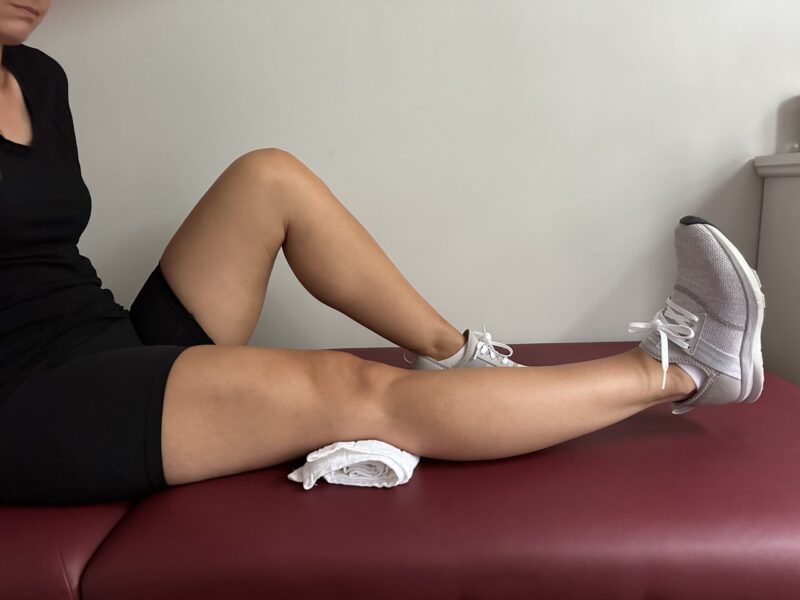
- Activates the quad muscle on the front of your thigh
- Important for restoring strength to your quad muscle
- Squeeze your thigh muscle for 3 seconds and repeat 20 times
- Use a small, rolled up towel behind your knee to push in to
4. Straight leg raise
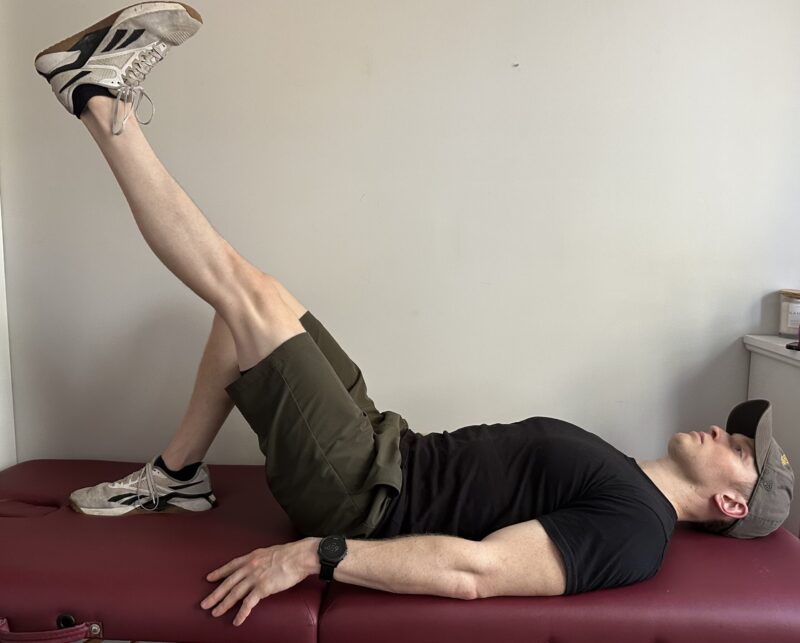
- Strengthens the quad muscle on the front of your thigh
- Keep your leg perfectly straight and lift it off the table
- When your leg reaches the height of your other knee, lower back to the table
- Perform 10 repetitions and complete 2 sets
5. Short arc quad

- Strengthens the quad muscle on the front of your thigh
- Leave the back of your knee on the foam roll and kick your heel off the table
- Perform 15 repetitions and complete 2 sets
- Best Foam Roll in the link below
6. Long arc quad

- Strengthens the quad muscle on the front of your thigh
- Kick your leg straight out and tighten your thigh muscle, then lower back down
- Perform 15 repetitions and complete 2 sets
- Best Ankle Weights in the link below
7. Heel slides

- Stretches your knee so you can bend it
- Slide your heel toward your butt and pull on the strap until you feel a strong stretch
- Hold 10 seconds and repeat 10 times
- Best Stretching Strap in the link below
Bonus helpful equpiment after a knee replacement: Ice and TENS
Quick Guide Part 2: Best Phase Two Exercises After a Knee Replacement (3-8 weeks after surgery)
1. Calf stretch on a slant board

- Stretches the muscle on the back of your lower leg
- Important for getting your knee perfectly straight
- Hold this stretch for 20 seconds and repeat 5 times
- Best Slant Board for this stretch in the link below
2. Heel raise/Toe raise
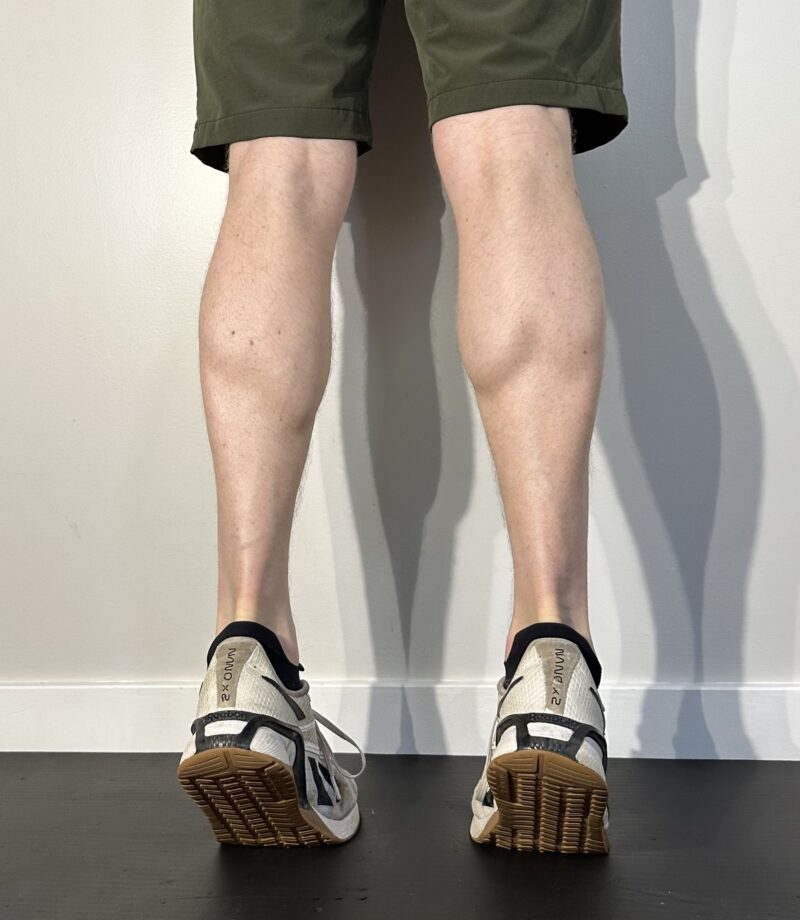
- Strengthens the muscles in your lower leg
- Important for restoring normal walking motion
- Perform 20 repetitions of heel raises
- Perform 20 repetitions of toe raises
- Compete two sets of the heel/toe raise exercise
3. Cone step-over

- Start on one side of the cone and step over the top to the other side
- Important for bending your knee and walking
- Perform 20 repetitions and complete 1 set
- Best Stackable Cones in the link below
4. Step-ups
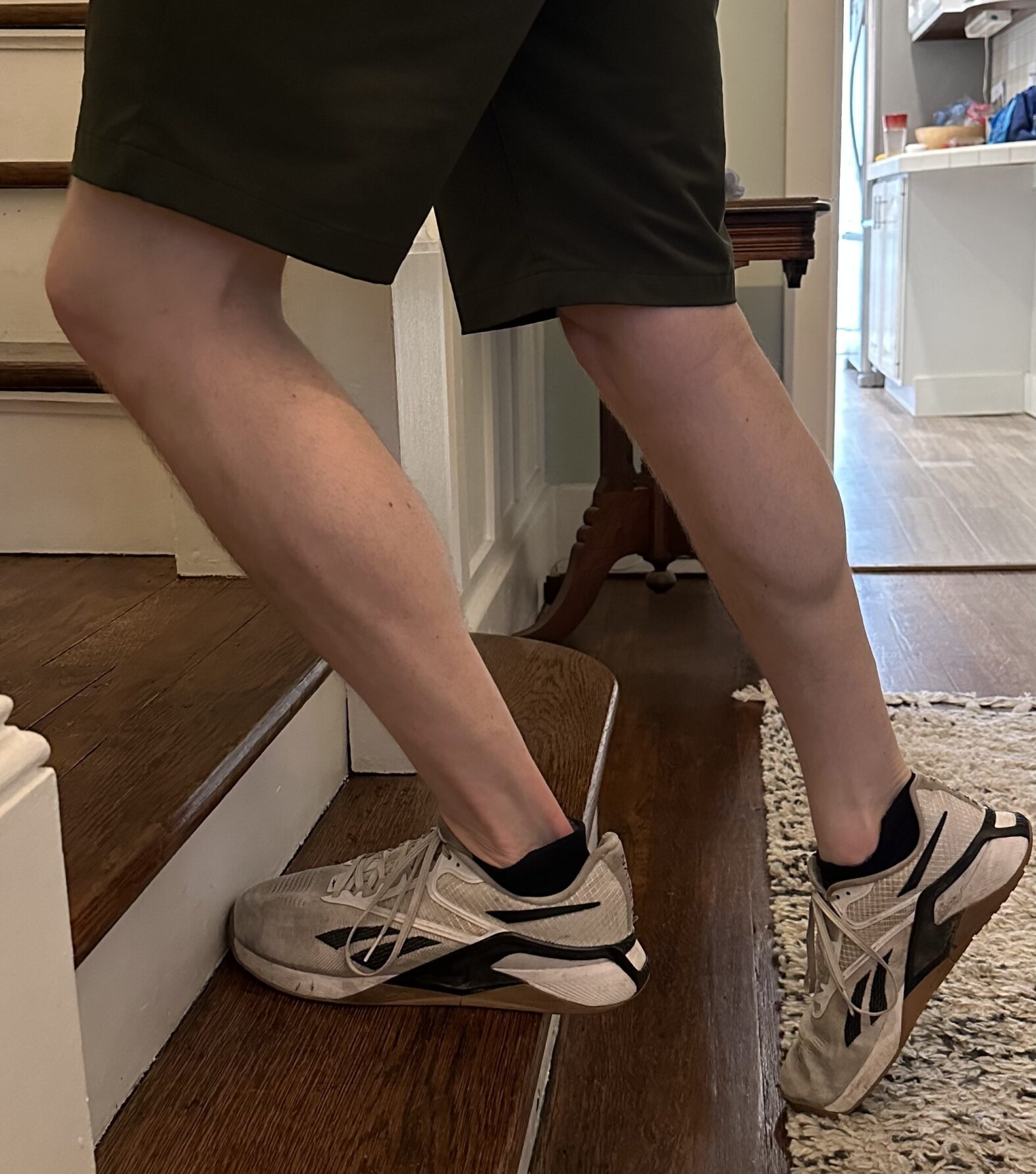
- Strengthens all of the muscles in your leg
- Important for restoring strength to go up and down stairs
- Perform 10 repetitions and complete 2 sets
- Best Adjustable Stepper in the link below
5. Lateral step-ups

- Strengthens all of the muscles in your leg
- Important for restoring strength to go up and down stairs
- Perform 10 repetitions and complete 2 sets
- Best Adjustable Stepper in the link below
6. Balance on foam

- Improves your balance and proprioception of your new joint
- Important for restoring balance and preventing falls
- Hold for 15 seconds and repeat 5 times
- Best Foam Balance Pad in the link below
7. Squat to a chair
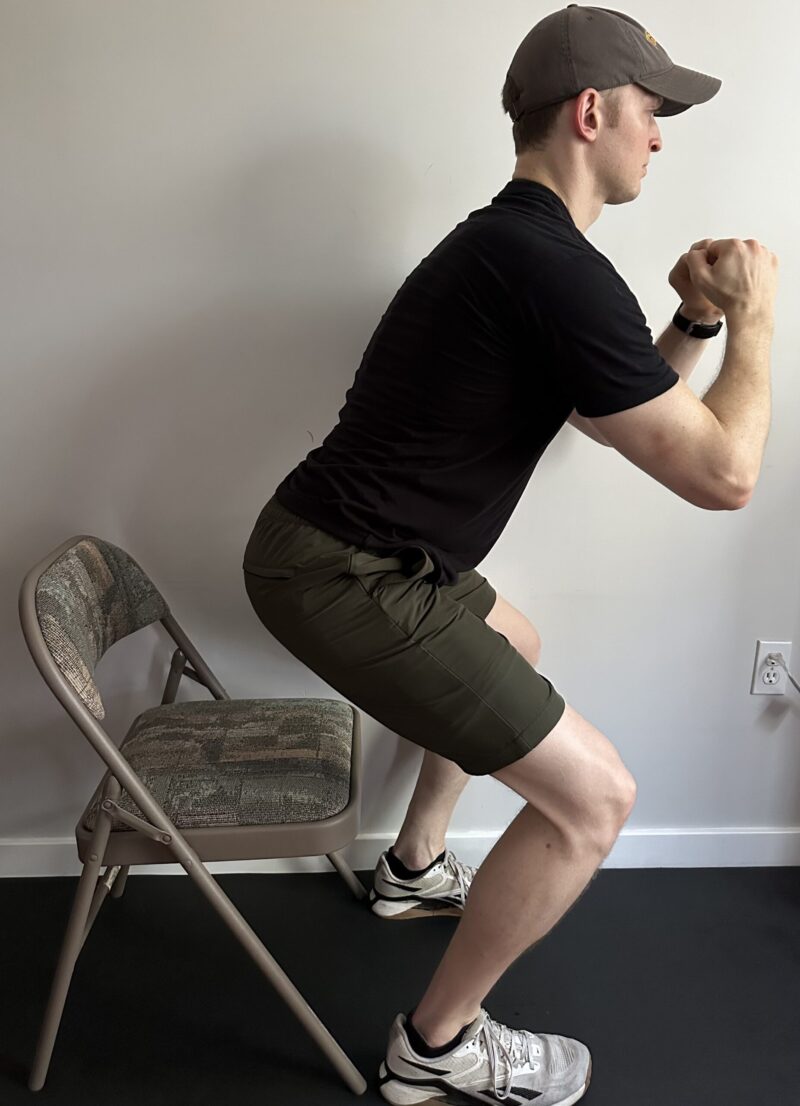
- Strengthens all of the muscle in your legs
- Important for improving your ability to get out of chairs and up from the toilet
- Perform 10 repetitions and complete 2 sets
- Best Foam Pad to adjust the height of the chair in the link below
Disclaimers and Disclosures: All information in this article is for informational and educational purposes only and should not be taken as individual medical advice. Additionally, this article contains affiliate links, meaning when you make a purchase, we make a small commission at no additional cost to you. For more information, see our full Disclaimers and Disclosures.
Are you looking for the best exercises to do after a knee replacement surgery?
If you’re looking to expedite your recovery and maximize your functional potential with the best exercises after your knee joint replacement surgery, then you’re in the right place! Knee joint replacements are one of the most common orthopedic elective procedures performed today and they help millions of people return to the activities they love to do. In a matter of just a couple of hours, a surgeon will replace your knee bones with a prosthesis that functions just like a healthy and pain-free knee.
Unfortunately, the easy part is over the day of surgery, then the hard work begins. What the surgeon doesn’t tell you is that it will take time, hard work, and dedication to restore your knee to this healthy and pain-free state. You have to work every day to increase the strength and flexibility of your new knee. Luckily, all of this work pays off and pretty much every single one of my patients tells me it was all worth it.
I have spent years cultivating the best program of treatments and exercises for my patients to do after their knee replacement surgery, and I want to share that program with you. In this article I will cover some background information on knee replacement surgery and then we will dive in deep together with explanations of the best exercises, how to perform them, and what the best equipment is to help you on your journey.
And then be sure to stick around at the end of the article for our most frequently asked questions about recovering from knee replacement surgery. If you’re looking to get started right away, then check out our quick guide to the best exercises after knee replacement right at the top of this article.
What is a knee replacement?
A knee replacement is a surgical procedure that involves removing the ends of the bones that form your knee joint and replacing them with a prosthetic device. Most often, a knee replacement is performed because arthritis has developed within the knee joint, which causes common activities to become difficult and painful. The new prosthesis creates a smooth joint surface which, after recovery, allows you to return to pain-free activities.
A knee replacement takes approximately 1-2 hours to complete and most people will return home in 1-2 days, but some can be discharged from the hospital the day of the surgery. During the surgery, the surgeon will need to make an incision along the front of your knee to gain access to your knee joint. They will then use a combination of sutures, glue, or staples to close the incision. It is becoming much more common to have robotic assisted surgeries, which allows for greater precision and smaller incisions.
What is the difference between a total knee replacement and a partial knee replacement?
The knee joint is made up of three different compartments: the medial knee compartment, the lateral knee compartment, and the patellofemoral compartment. In a total knee replacement, the surgeon replaces all three compartments of the knee. With a partial knee replacement, the surgeon is replacing only one compartment, which is why another name for a partial knee replacement is a unicompartmental knee replacement.
With a total knee replacement, the surgeon will remove the bottom of your femur (thigh bone), the top of your tibia (shin bone), and the back of your patella (knee cap). They will also remove your ACL and PCL, which are ligaments in your knee joint, and all of this will be replaced with a metal and plastic implant. The exact materials of the metal and plastic can vary, so I suggest asking your surgeon if you’re curious what your new knee is made out of.
With a partial knee replacement the most common compartment that is replaced is the medial knee compartment. This is because the medial knee compartment is usually more severely affected by arthritis. The ACL and PCL are usually left intact with a partial knee replacement. However, if the ACL is not able to be salvaged, then the surgeon will use a slightly different implant to accommodate for this.
How do I know I need a knee replacement?
If you have knee pain caused by arthritis that is affecting your ability to enjoy daily activities, and you have failed to improve with conservative treatments, then it is time for a knee replacement.
The first order of business to determine if you need a knee replacement is to get an x-ray to confirm the diagnosis of arthritis and determine its severity. The doctor will look at how much joint space narrowing you have, which will give an indication of the progression of the arthritis in your knee. Additionally, they can sometimes see osteophytes (bone spurs) around the joint, which is another indication of how severe the arthritis is.
At this point the doctor will likely recommend a corticosteroid injection. This injection is designed to reduce the inflammation within the knee joint, which can sometimes provide temporary pain relief. Some of my patients report getting six months or more of relief with the injection, but some report no change at all. Unfortunately, you don’t know which camp you will fall in until you try it.
The next order of business, if you haven’t already done so, is to get started on a high-quality physical therapy exercise program. An exercise program including resistance training and flexibility exercises is proven to have the greatest effect in reducing pain and improving functional ability compared to all other conservative treatments for knee osteoarthritis.
The last-ditch effort to avoid a knee replacement is hyaluronic acid injections, provided by your doctor. This is essentially a lubricating fluid that is injected in your knee joint with the goal of smoothing out the motion of your knee and reducing pain. Like the corticosteroid injection, it’s basically luck of the draw if this provides relief or not.
Once you have tried all of these conservative treatments, but you still aren’t happy with your level of function, then you will know you need a knee replacement. I tell my patients if they are still questioning the decision, when it’s truly time to go through with a knee replacement, your body will let you know.
How long does it take to recover from knee replacement surgery?
The vast majority of your recovery after knee replacement surgery will occur in the first three months. However, you can continue to make improvements in your strength, range of motion, and functional ability for up to a year after surgery. In fact, most patients report it takes six months to a year before they go through an entire day without thinking about their knee.
Even though you can continue to make improvements for a long time after surgery, it is important to work your hardest in the first eight weeks, because this is where you will see your biggest gains. Typically, knee replacement surgery is 1-2 hours, the hospital stay is 1-2 days, home health therapy is 1-2 weeks, and outpatient physical therapy is 1-2 months.
This is a total of three months of hard work and dedication. I tell my patients to think of it as an investment in their future. If they put in the hard work now, it will pay off for the rest of their lives.
How does this guide help after my knee replacement surgery?
For optimal recovery after your knee replacement surgery, we break down your exercises into different phases. The initial (phase one) exercises emphasize restoring range of motion and strength, while also reducing swelling and pain. The intermediate (phase two) exercises are important for higher levels of strength and improving your functional ability with daily activities. These two phases are all that is required if your goal is to get back to normal walking, climbing stairs, gardening, and other lighter activities.
The advanced (phase three) exercises after knee replacement are only needed if your goals are to get back to higher intensity endeavors. These include activities such as sports, skiing, rock climbing, and functional fitness. Because these advanced exercises are more specific and tailored to the sport or activity, I will cover this phase of exercises in another article. You can also take a look at the FAQ section at the bottom to see if I have any quick tips or tricks for your specific activity.
A final note before we dive into our in-depth exercise breakdown. If you’re within the first week after your surgery, see our detailed guide to week 1 knee replacement exercises.
Phase one exercises after knee replacement: In-depth exercise description and equipment recommendations
Phase one exercises after knee replacement include: hamstring stretch, calf stretch, quad set, straight leg raise, short arc quad, long arc quad, heel slides, and recumbent bike. These exercises should be started the day of your surgery and you should perform them two times a day, every day for three weeks.
1. Hamstring Stretch

How to perform the hamstring stretch with a strap.
Start by lying on your back with both legs straight and the strap around the middle of your foot. Keep your knee straight and use the strap to pull your leg straight up until you feel a stretch in the back of your leg. Once you feel the stretch, hold it for 20 seconds and then lower back down to the start position. Rest for a second or two and repeat this 5 times.
Professional tips: Having a slight bend in your knee is ok to start out. But as your body gets used to this stretch, you should work to keep your knee as straight as possible.
Why the hamstring stretch is a good exercise after knee replacement.
It is imperative that we restore full extension to your knee joint after surgery. This means we need to get your knee completely straight, otherwise it will impair your ability to walk normally and you could end up with a limp. The hamstring muscle tightens up after surgery and prevents your knee from straightening completely. The hamstring stretch will reduce the tightness in this muscle and allow your knee to straighten back out.
What is the best equipment for the hamstring stretch with a strap?
The Stretch Out Strap is the best option for several reasons. It is 6 feet long and has multiple loops and handles all along its length. This makes it good for people of different sizes and allows you to get the most comfortable grip. It is also very durable and we have had thousands of patients use it in our clinic and most of them end up buying one for their own use at home. The Stretch Out Strap can be found in the link below.
It’s also nice to have a firm but soft surface to perform this stretch on. Many of our patients will start their exercises in bed after a knee replacement but most people prefer a surface that is a little more firm. You can use a portable massage table, which is firm enough that you don’t sink into it but soft enough to make it quite comfortable. This massage table is collapsible and portable and allows you to perform your physical therapy routines at home like our patients do in the clinic. The Massage Table can be found in the link below.
2. Calf Stretch

How to perform the calf stretch with a strap.
Start by lying on your back with your leg straight and the strap around the ball of your foot. Keep your knee straight and pull your foot and toes back toward you by pulling on the strap. Once you feel the stretch in the back of your leg, hold it for 20 seconds and repeat 5 times.
Professional tip: If you can’t feel the stretch at first, actively pull your toes toward your nose first, and then give extra pressure by pulling on the strap.
Why the calf stretch is a good exercise after knee replacement.
The calf muscles, like the hamstring muscle, crosses behind the knee and will limit your ability to fully straighten your knee after a knee replacement. This exercise will stretch out your calf muscle and allow you to straighten your leg all the way. We will be doing another, more intense, version of this stretch in phase two, but the calf stretch with a strap is the best calf stretch for rehabbing an injury in the acute phase.
What is the best equipment for the calf stretch with a strap?
The Stretch Out Strap is the best option for several reasons. It is 6 feet long and has multiple loops and handles all along its length. This makes it good for people of different sizes and allows you to get the most comfortable grip. It is also very durable and we have had thousands of patients use it in our clinic and most of them end up buying one for their own use at home. The Stretch Out Strap can be found in the link below.
I would suggest using the massage table from the hamstring stretch above, which you will be able to use for all of your exercises in phase one. However, every once in a while I will get a patient that prefers to do their exercises on the floor. I do no suggest this initially because it is very difficult to get up and down from the ground for the first few weeks after a knee replacement. But if I can’t talk you out of it then at least make sure to use a nice thick yoga mat to make things more comfortable. The Yoga Mat can be found in the link below.
3. Quad Set

How to perform the quad set with a towel roll.
Start by lying on your back with your knee straight and a small rolled up towel under your ankle. Tighten your thigh muscle and push the back of your knee straight down toward the table. Focus on feeling a squeeze in the muscle on the front of your thigh and hold it for 2-3 seconds. Then relax and repeat this 20 times.
Professional tips: This exercise is also designed to help you regain full extension range of motion. Because of this, it can be a little uncomfortable when you first start. This is normal as long as the discomfort is tolerable and you should mostly feel it behind your knee.
Why the quad set is a good exercise after knee replacement.
The quadriceps muscle on the front of your thigh is crucial for walking, climbing stairs, and getting out of a chair. Not only does the surgeon have to cut through a part of your quad muscle, but the swelling after surgery basically turns your quad off. The quad set exercise helps to turn your quad back on and allows you to regain control of the muscle.
What is the best equipment for the quad set with a towel roll?
A rolled-up hand towel that is a couple inches in diameter will work just fine. The purpose of the towel is to prop your ankle up a few inches so your knee isn’t in contact with the table. This is what will allow you to get your knee fully straight again instead of having a little bend in your knee.
4. Straight Leg Raise

How to perform the straight leg raise.
Start lying on your back with your involved leg straight and your uninvolved leg bent to a 90-degree ankle. Tighten the muscle on the front of your thigh, keep your leg straight, and lift it off the table until it is parallel to your other thigh. Pause for a second and then return to the starting position. Repeat this 10 times, take a 30 second break, and perform 2 sets.
Professional tips: Your leg is going to feel like a lead weight after this surgery and there is a very good chance you won’t be able to lift your leg even an inch off the table. This is normal and totally ok; all I do with my patients is place my hand under their ankle and help them to lift their leg. For the first few days (or weeks) after surgery, I’m actually doing most of the work. But as long as you are putting in the effort, and maybe have a friend to help out, you will be able to lift your leg on your own soon.
Why the straight leg raise is a good exercise after knee replacement.
The straight leg raise is the next level of difficulty up from the quad set exercise for strengthening your quadriceps. When you first ty this exercise, your leg is going to feel like a lead weight because your quadriceps is so weak. As this exercise gets easier, your quad muscle will get a stronger and you may even feel confident enough to transition from a walker to a cane when you can perform 10 repetitions without your knee bending.
5. Short Arc Quad

How to perform the short arc quad with ankle weights.
Start lying on your back with a bolster under your knee. Slowly, kick your heel off the table until your leg is straight but make sure the back of your knee stays in contact with the bolster. Try to tighten your quad muscle at the top position and then return to the start. Repeat this 15 times, take a 30 second break, and perform 2 sets.
Professional tips: The first time you do this exercise try it without any weight. If it is easy and relatively pain-free then you can try adding a pound to the ankle weight. Slowly keep adding weight over the days and weeks, but it’s better to go a little slower rather than overdoing it.
Why the short arc quad is a good exercise after knee replacement.
The short arc quad is one of very few exercises that truly isolates your quad muscle. This exercise works on the strength of your quad muscle, especially near the end range of extension, where your quad is weakest. You can also add ankle weights to the short arc quad as you progress, which will help you to get stronger and stronger.
What is the best equipment for the short arc quad with ankle weights?
It is important for the ankle weights to fit comfortably and securely around your ankle. Another really nice feature is the ability to adjust the amount of weight that it holds. These ankle weights meet all of these criteria, are highly rated, and are sold in pairs which can give you even more weight to use if you’re feeling extra strong! The Ankle Weights can be found in the link below.
The bolster that your knee is supported on should be firm but comfortable. A diameter of about 6 inches works best, so a foam roller is my favorite piece of equipment for this exercise. It’s also really nice because you can use it for other mobility work you may do such as rolling out your quads, IT band, and hamstrings. I love getting pieces of equipment that can serve a bunch of different purposes and be used over and over again. The Foam Roll can be found in the link below.
6. Long Arc Quad

How to perform the long arc quad with ankle weights.
Start sitting in a chair or on the side of your bed with your knees bent. Slowly kick your foot all the way out until your leg is straight but keep the back of your thigh on the surface you’re sitting on. Try to tighten your quad at the top position for a second and then return to the start position. Repeat this 15 times, take a 30 second break, and perform 2 sets.
Professional tips: Just like the short arc quad exercise, the first time should be performed without any weight. If the exercise is easy and relatively pain-free then you can add a pound to the ankle weight and slowly keep progressing to build back the strength in your quadriceps.
Why the long arc quad is a good exercise after knee replacement.
The long arc quad is another exercise that isolates your quad muscle. It is similar to the short arc quad but this exercise works your quadriceps through a bigger range of motion. This larger range of motion will eventually help you to be able to get up from lower chairs as well as get up from the ground.
What is the best equipment for the long arc quad with ankle weights?
It is important for the ankle weights to fit comfortably and securely around your ankle. Another really nice feature is the ability to adjust the amount of weight that it holds. These ankle weights meet all of these criteria, are highly rated, and are sold in pairs which can give you even more weight to use if you’re feeling extra strong! The Ankle Weights can be found in the link below.
7. Heel Slides

How to perform the heel slides with a strap.
Start lying on your back with the strap around the middle of your foot. Try to relax your leg and slowly pull on the handles of the strap so your knee bends and your heel slides up toward your butt. Keep pulling until you feel just a gentle stretch across your knee. Once you feel the stretch, hold it there for 10 seconds then return to the start position and repeat 10 times.
Professional tips: I usually tell people this exercise is most people’s least favorite for the first couple of weeks due to the discomfort associated with it. So if you’re feeling this discomfort then you’re in good company. This is normal, but we want it to be tolerable and the pain should go away very quickly when you’re done with the exercise.
Why heel slides are a good exercise after knee replacement.
Heel slides are the best exercise after knee replacement for improving the bend of your knee. Early after a knee replacement, the majority of your time should be spent on getting your knee as straight as you can. This is because the window of time to achieve full extension is shorter, on the order of 3-4 weeks. On the other hand, you can see improvements in the ability to bend your knee for 3-4 months.
However, this doesn’t mean you can slack off with your bending exercises. You need to work just as hard on the bend, because the further out from surgery you get, the stiffer your knee becomes. The heel slide exercise is most of my patients’ least favorite exercise because it is so uncomfortable. Although it’s uncomfortable, I encourage you to push hard and do a few extra reps here and there, because this is going to get your knee healthy again.
What is the best equipment for the heel slides with a strap?
The stretch out strap is the best option for several reasons. It is 6 feet long and has multiple loops and handles all along its length, so it is good for people of different sizes and allows you to get the most comfortable grip. It is also very durable and we have had thousands of patients use it in our clinic and most of them end up buying one for their own use at home. The Stretch Out Strap can be found in the link below.
We want your heel to slide with as little friction as possible. If you’re doing this exercise on your hardwood floors with socks on, then consider this pretty frictionless. However, if you’re exercising on a massage table, on a couch, or in your bed then using a slide board can be helpful to make this exercise nice and smooth. We use the slide board for our patients in the clinic when they’re on the mat tables and need a smooth surface. The Slide Board can be found in the link below.
Calm Swelling and Inflammation after Knee Replacement with Ice and TENS
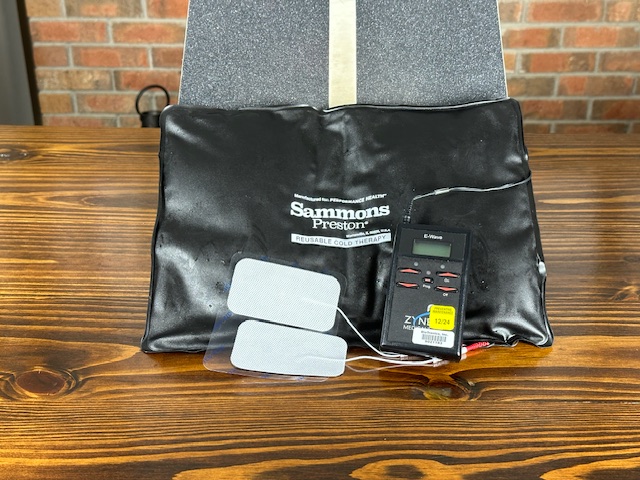
How to use ice and TENS after a knee replacement.
I like to have my patients lie on their back with their leg propped up so the knee is above heart level, this will also help with getting rid of the swelling. Then I place the pads of the TENS unit on either side of the knee cap. I then wrap the knee in a pillowcase to place a barrier between the skin and the ice, and then I’ll place one ice pack behind and one on top of the knee so the whole joint is surrounded.
Professional tips: Turn up the TENS until you feel a comfortable tingling sensation. This isn’t one of those “the stronger the better” scenarios, so only increase the TENS until it is at a very comfortable level for you. Keeping the ice and TENS on for 10-15 minutes at a time seems to be the optimal timeframe for reducing pain and inflammation.
Why ice and TENS is helpful after a knee replacement.
A knee replacement is an involved surgery that can create a lot of trauma to the surrounding tissues. Almost invariably, patients will have substantial swelling after surgery that can last for months. This swelling limits your range of motion, reduces your quadriceps ability to work, and delays healing.
Ice and TENS work well together to reduce your swelling and pain after knee replacement surgery. These modalities are most important immediately following surgery and for the 2-3 weeks after. However, some patients enjoy using the ice and TENS for 6-8 weeks to continue to help with swelling and pain. The ice should be used for 20 minutes of every hour for 3 days immediately after your surgery. Then, the ice and TENS can be used for 10-15 minutes after your exercise routine.
What is the best equipment for ice and TENS after knee replacement surgery?
It’s pretty hard to beat the TENS units we have in the clinic. But considering those units are over $3,000, this portable unit with great reviews for under $50 is an excellent alternative. This unit comes in a travel case, with two channels allowing for 4 electrode placements, and runs on a 9 volt battery. Consider this simple but effective pain relief. The TENS Unit can be found in the link below.
These ice packs are exact replicas of the ones we use in the clinic, and our patients love them! I have had so many patients ask for a recommendation on where they can get the ice packs that we use. They are sick of hard ice packs that don’t conform, or using bags of peas from their freezer that just don’t work as well as they want them to.
These ice packs are large, reusable, and conform to various body parts so you can use them over and over again on any aching joints. I suggest you get a small and a medium so you can wrap your entire knee, front and back. Some people like to get a handful of the ice packs so they can keep one sets in the freezer, nice and cold, while they’re using the other set. The Ice Pack can be found in the link below.
Phase two exercises after knee replacement: 3-8 weeks after surgery
Phase two exercises after knee replacement include: heel raise/toe raise, calf stretch on a wedge, cone step-overs, step-ups, lateral step-ups, balance on foam, and squat to a chair. You should continue to perform the phase one exercises two times per day and add in the phase two exercises, once per day.
1. Heel Raise/Toe Raise

How to perform the heel raise/toe raise.
Start standing in front of your counter or another stable object you can hold on to. Slowly raise your heels off the ground so you are standing on tip toes, then return to the start position. Then raise your toes off the ground so you are standing on your heels, then return to the start position. Repeat both of these actions 20 times, take a 30 second break, and perform 2 sets.
Professional tips: It’s ok to gently rock forward when you go on your toes and back when you go on your heels, but try to stay standing nice and tall the whole time without too much forward and backward motion.
Why the heel/toe raise is a good exercise after knee replacement.
The heel/toe raise exercise strengthens your calf muscle and tibialis anterior muscle on the front of your shin. Both of these muscles are extremely important for getting back to walking normally. Additionally, the exercise begins to build the rocker motion of the foot and ankle, which will help you to walk without a limp.
2. Calf Stretch on a Slant Board

How to perform the calf stretch on a slant board.
Start by placing the slant board in front of your counter or another stable object you can hold on to. Place both feet on the slant bord with your toes facing forward and your knees nice and straight. Stand tall and then gently lean your whole body forward and keep your heels down on the board the entire time. Once you feel the stretch in the back of your legs, hold it there for 20 seconds and repeat 5 times.
Professional tip: Start with a gentle stretch at a lower incline. Then, as you gain mobility, you can try higher inclines on the slant board.
Why the calf stretch on a slant board is a good exercise after knee replacement.
We did a version of the calf stretch in phase one, and this stretch is like that but on steroids. You will feel a much more intense stretch in your calves with this version, in fact, we rate it as the best overall calf stretch for loosening up tight leg muscles. The calf stretch on a slant board will really help to loosen up your tight calves and restore extension to your knee joint.
What is the best equipment for the calf stretch on a slant board?
My favorite piece of equipment for performing the calf stretch on the slant board is the StrongTek Professional Wooden Slant Board. This is almost exactly like the slant board we have been using in the clinic with our patients for well over a decade now.
It is adjustable with 5 different angles for calf stretches so you can vary it from 15 degrees all the way to 35 degrees. This allows you to start with a gentle stretch and progress the angle as you gain flexibility. Also, it has anti-slip tread on both the surface as well as the bottom so you can safely perform this stretch without the risk of slipping.
Additionally, it’s made of hardwood plywood which makes it more durable than other slant boards, with up to a 450-pound capacity. Finally, it’s 12”x16” so you don’t have to worry if you have big feet or do this stretch with your shoes one, there will be plenty of room for your feet.The Slant Board can be found in the link below.
3. Cone Step-over

How to perform the cone step-over.
Start by placing a cone in front of your counter or other stable surface. Grab on to the counter with your hands and stand on one side of the cone, on one foot. Step directly over top of the cone to the other side and then bring your other leg over to that side as well. Then step back to the original side in the same fashion. This counts as one repetition, perform a total of 20 times.
Professional tips: Make sure to step right over top of the cone with both feet every time you step. It doesn’t count if you sneak one or both feet around the cone instead of over the top. As you get better and if this exercise is easy, you can stack cones on top of each other so it turns into a higher target.
Why the cone step-over is a good exercise after knee replacement.
After a knee replacement, people will walk with a stiff knee and not allow it to bend a normal amount. The cone step-over exercise forces you to actively bend your knee and step over a target, then transfer your weight to that leg. This pattern mimics the motion of walking and encourages muscle memory to restore a normalized gait.
What is the best equipment for the cone step-over exercise?
These stackable cones are very similar to what we use in the clinic. They’re about 7 inches tall, which is a good starting height, and then you can stack them on top of each other to increase the height of the target as you gain more mobility. The Therapy Cones can be found in the link below.
4. Step-ups

How to perform the step-ups.
Start by placing a small step perpendicular to your counter or other stable surface. Hold on to the counter with one hand and step up on the platform with your unaffected leg, then bring your affected leg up on the platform. Return back to your start position by stepping backward in the same sequence.
Once you have completed 10 step-ups leading with the unaffected leg, then perform 10 repetitions leading with the affected leg. Take a 30 second break and perform 2 sets with each leg.
Professional tips: Start with a 4-inch step height when you begin this exercise. Once you can perform all the repetitions without pain and with relative ease, increase the step height by 2 inches. A normal height step is 8 inches, so I have my patients work toward this goal.
Also, use your hand on your unaffected side to hold onto the counter. Holding on with this hand will distribute your weight more evenly and take pressure off your injured knee. As you get better and gain confidence, you can try this exercise without holding on.
Why the step-up is a good exercise after knee replacement.
Step-ups are one of the best ways to build strength in your hip and thigh muscles. You can start at a low step height early after knee replacement surgery, when your muscles at are their weakest. Then, as you gain strength you can slowly increase the step height to make it more demanding and make your muscles even stronger.
The step-up exercise has the added benefit of being a very functional movement. Most people will notice more pain and difficulty with going up and down stairs leading up to their knee replacement surgery, and this won’t be any easier immediately after the surgery either. By incorporating the step-ups as part of your exercise routine, we will be working toward you goal of making stair negotiation pain-free.
What is the best equipment for the step-up exercise?
For this exercise, you will want a stepper that is adjustable and that has good traction. The stepper below is nonslip and allows for variable heights so you can progress as you get strong and feel better. These are the same steppers we use in the clinic, so I know they are durable and work well. The Stepper can be found in the link below.
5. Lateral Step-ups

How to perform the lateral step-ups.
Start by placing a small step perpendicular to your counter or other stable surface. Stand facing the counter and hold on to it with both hands and the stepper to your side. Step up on the stepper with both feet, then step down to the other side of the stepper. Then return back to your start position in the same manner going up and over the stepper with both feet.
Over and back counts as one repetition. Perform 10 repetitions, take a 30 second break, and complete 2 sets.
Professional tips: Start with a 4-inch step height when you begin this exercise. Once you can perform all the repetitions without pain and with relative ease, increase the step height by 2 inches. A normal height step is 8 inches, so I have my patients work toward this goal.
Why the lateral step-up is a good exercise after knee replacement.
The lateral step-up builds strength in your hip and thigh muscles, just like the forward step-up exercise. The lateral step-ups just work at a little different angle, which helps to recruit slightly different muscles and work your muscles in a different way. Additionally, it is important to work some lateral movements into the program which will help to increase the stability of the knee joint.
What is the best equipment for the lateral step-up exercise?
You can use the same stepper that we used for the step-up exercise. I like to start at the same height and slowly progress over time. This stepper is great because of its versality and the number of exercises you can do on it. We have hundreds of patients do dozens of different exercises on them, so they come in pretty handy. The Stepper can be found in the link below.
6. Balance on Foam

How to perform the balance on foam exercise.
Start by placing the foam balance pad in front of your counter or other stable surface. Stand on the foam pad facing the counter and hold on to it with both hands. Raise your good foot off the foam pad so you are just standing on your bad leg. Once you feel balance, slowly raise your hands off the counter and hold them there. The goal is to balance on one leg for 15 seconds, and just make small corrections with your hands or other foot if you need to. Once you reach 15 seconds, then repeat on the other side to give your leg a break. Repeat this a total of 4 times on each side.
Professional tips: Start without the foam pad and just perform this exercise on the floor. Balancing on one leg is often trickier than people expect, especially after a surgery. Once you are able to get through all 4 repetitions without having to hold on to the counter or put your other foot down, then you can try on the foam pad.
Why the balancing on a foam pad is a good exercise after knee replacement.
Our balance naturally declines as we age, so doing balance exercises is important for everyone, especially as we get older. However, our balance becomes even more impaired following an injury or surgery. By performing balance exercises, you will be able to improve your balance and decrease the risk of falling. Additionally, balance exercises force all of the muscles surrounding your knee to work in concert together to provide more stability to the knee joint.
What is the best equipment for balancing on a foam pad?
The Airex balance pad is what we have used in our clinic for well over a decade now. It was designed specifically for balance exercises and what most studies have been performed on. It is durable as well as reliable and I would consider it the number one brand trusted by physical therapists for balance exercises. The Airex Balance Pad can be found in the link below.
7. Squat to a Chair

How to perform the squat to a chair exercise.
Start by standing in front of a chair with a foam pad in it to increase the height. Slowly sit your butt back and control your descent so you do not plop down. Then, without using your hands, stand back up to the start position. This counts as one repetition. Perform 10 repetitions, take a minute break, and complete 2 sets.
Professional tips: Start with the foam pad to increase the height of the chair, which makes it easier to stand up and sit down. Once you can complete 2 sets of 10 repetitions, then remove the foam pad so it is a normal height chair, which makes this exercise more difficult. You can perform
Why the squat to a chair is a good exercise after knee replacement.
Squats to a chair are one of the best and most functional movements we perform. Think of how many times in a day, and throughout our entire lives we have to stand up from a chair, a toilet, the bed, a low garden seat. Working on this movement will improve the strength of your legs and make it so you can keep doing the functional activities that are important to you.
There is a strong correlation between being able to stand up from low surfaces without using your hands and longevity. So if you want to live a long and healthy life, then make the squat to a chair exercise part of your daily routine.
What is the best equipment for squats to a chair?
The Airex balance pad is perfect, since you will have one lying around from the previous balance exercise. This is exactly what we use in the clinic to raise the height of the chair and make this exercise a little easier. Then, once you have gained enough strength, get rid of the foam pad and just do the squats to the height of a normal chair. But keep the pad and use it for balance, because that is another good exercise for longevity.
Final Thoughts on Best Exercises After a Knee Replacement
Getting your knee replaced is a big decision and it’s important to go into it with a plan and then even more important to follow that plan after the surgery. Throughout my career as a physical therapist, I have treated hundreds, if not thousands, of patients for their knee replacements and you now have the same program to follow as them. I feel confident these are the best exercises after a knee replacement to improve your mobility, get you stronger, and get you back to the activities that you love to do. Knee replacements are one of my favorite diagnoses to treat, so thank you for trusting me to help you on your journey, I know you will do great!
Frequently Asked Questions About Knee Replacement Exercises
You will begin your exercises the day of your knee replacement surgery. A physical therapist from the hospital will take you through exercises either in your bed or in the rehabilitation room at the hospital. Additionally, they will teach you how to walk with your walker, how to go up and down stairs, and may even get you on the recumbent bike to work on the motion of your knee.
Once you are discharged from the hospital, you can begin to perform the first phase of exercises above. It is important to get started with these exercises early, which will help to quicken your recovery after surgery.
The heel prop exercise is the best way to straighten your leg after a knee replacement. Low load, prolonged duration stretching is the best way to increase tissue extensibility. This exercise uses the weight of your leg and gravity to provide a stretch to your knee, so it can be performed anywhere. I tell my patients to sit on their couch, place a pillow on their coffee table, and then place their foot and ankle on the pillow. This way, there is nothing behind your knee and then you just let gravity do the work of pulling your knee into extension.
Set a timer for at least 5 minutes with the goal of increasing up to 10 minutes and do this exercise 3 times per day. This stretch is pretty easy for the first few seconds or minute, but then it will get really sore and uncomfortable, especially behind your knee. I suggest that you put something on tv to distract you from the discomfort, because the last two minutes can feel like two hours!
Professional tip: If you get to the point where you do 10 minutes and don’t feel much of a stretch, you can place a light ankle weight or a blanket/quilt on top of your knee. This will force your knee into a little more extension and give you a better stretch. I usually start with just 1# and typically won’t use more than 5#.
For optimal results you should perform your exercises 2-3 times per day after your knee replacement. I recommend that my patients perform their exercises 2 times per day, but if you feel like you have energy and are not too sore after the exercises, then you can perform an additional set.
The hardest days after a total knee replacement are the first few days after the surgery. This is where the pain and swelling are at their worst and patients will find it most difficult to sleep and get comfortable. The majority of my patients report waking up every couple of hours and having to find a new position or sometimes having to take a short walk.
While this is difficult to deal with, know that the pain will gradually lessen and you will be able to sleep for longer of stretches of time through the night. However, it is normal for it to take up to 8 weeks before you can sleep through the whole night.
While too much walking will not damage a knee replacement, you can injure the surrounding tissue and cause more inflammation and swelling. Early after knee replacement surgery, I tell my patients that it is important to get up and walking around frequently, however keep the duration and the distance small. Think of taking small walks around the house, a bunch of times throughout the day. Then as you gain strength and heal from the surgery, you can slowly take longer walks as long as you don’t experience an increase in pain or swelling from it.
It is not advised to kneel or squat too deep early after knee replacement surgery. You will not have adequate strength or range of motion to squat, and the incision is not healed enough to kneel. Once the incision is completely healed, and you are 2-3 months out from surgery, you can start kneeling on very soft surfaces such as a pillow or a bed. Then as you gain confidence you can kneel normally, but I always suggest to have a soft surface or a pad to kneel on.
For squats, you can begin with the squat to a chair exercise mentioned above. As you gain strength and range of motion, slowly lower the height of the chair to make it a little more difficult. The next step is to take away the chair and just perform normal squats, but you may find that you are never able to do a full-depth squat following knee replacement.
Stationary biking is one of the best exercises after knee replacement. It is a great way to work on the bend of your new knee, while also strengthening your quad muscle. The stationary bike is a favorite exercise in physical therapy and all of the physical therapists in our clinic use the bike for patients with knee replacements.
You will start by performing a rocking motion on the bike, not actually completing full revolutions. Once you have enough bending motion in your knee, usually by 3-4 weeks, you will be able to complete full revolutions on the bike. I don’t recommend that my patients use the bike as an actual cardio workout until they can easily complete 5 minutes of full revolutions without any soreness, usually 2-3 months after surgery.
The goal knee bend after a knee replacement is at least 120 degrees. The reason for this is because most of the functional movements such as getting in and out of a car, standing up from a low chair, and getting dressed can be accomplished with 120 degrees of bend.
The goal for my patients is always 130 degrees. I have found that most people will lose a few degrees of bend over time once they have stopped doing their exercises. I like to make sure and give you some wiggle room, so you have confidence and can do these tasks with ease.
Rehabbing after a knee replacement is a long, hard, often painful process. The good news in all of this is that the vast majority of patients all say it was worth it in the end. During the process of rehabilitation, it’s not uncommon to hear the refrain from many patients “I will never do this again”. However, I truly can’t tell you at this point in my career how many of my patients have told me this, only for me to see them 2-3 years later for their other knee. And they all say it was definitely worth it.
Compression after a knee replacement surgery is beneficial for reducing swelling and improving circulation, which will help the healing process. Many patients find that compression garments can be cumbersome to wear and difficult to put on. But if you’re looking to expedite your recovery process and promote healing, then it can be worth it to wear compression stockings for a few weeks after surgery.
We recommend a compression garment that starts on your foot and extends up to mid-thigh. Additionally, the pressure of the compression should be in the range of 15-30 mmHg and provide a gradient to promote proper blood flow. Always make sure the compression is not cutting off circulation with alterations in limb color or numbness/tingling. The compression garment below checks all of these boxes and receives positive reviews from patients following their knee replacement surgery.
It is generally recommended not to run after a total knee replacement. Running and other high impact activities can damage the implant over time and significantly reduce the life expectancy of the new joint. Short and infrequent jogs, like jogging to catch up with a missed bus or to keep a toddler safe, is fine for your new knee. However, you should avoid repetitive and high impact activities such as running.
Due to the risk of infection, you should avoid getting in a hot tub after knee replacement surgery until your incision is completely healed. Most surgeons have specific recommendations on when you can get back into a hot tub, so make sure to ask them at your follow-up appointment. Generally, your incision will be healed enough to get into a hot tub approximately 6-8 weeks after your knee replacement.
Generally, you should do your rehab exercises after knee replacement for 3-4 months. Some people will be able to get back to their prior level of function as early as 2 months, and some people may need to continue to work on their exercises for 5-6 months. The majority of progress will be made in the first 3 months after your knee replacement surgery.
Because of this, I recommend being extremely diligent for the first three months or until you reach your goals. Then you should select 4-5 exercises, usually the ones that are most difficult or you feel provide the most benefit. Continue to perform these exercises 3 times per week for another 2 months as part of a maintenance routine.
Exercises that are high impact such as running and jumping are not good after knee replacement. Running and jumping cause too much repetitive force to a knee replacement and will shorten the life expectancy of the implant. Lower impact activities such as cycling, swimming, and lifting are better for your new knee joint and will help it to last longer.
Why trust Physical Therapy Simplified for exercises after knee replacement?
At Physical Therapy Simplified, our mission is to provide an easily accessible and highly reputable source of physical therapy information that anyone can understand, follow, and benefit from. We want you to feel confident that you are getting the best content and information that will help to reduce your pain and restore you to your highest functional potential.
The author of this article, Andrew Harkins, DPT, has demonstrated expertise in the field of physical therapy and is certified by the American Board of Physical Therapy Specialities as an Orthopedic Clinical Specialist. He has over ten years experience as a licensed physical therapist and is an expert in treating conditions related to the knee.
Andrew has worked as a teaching assistant at the University of Pittsburgh in their Doctor of Physical Therapy Program. Specifically, due to his expertise in treating knee conditions, he assisted in musculoskeletal coursework and provided instruction on how to treat knee replacements.
